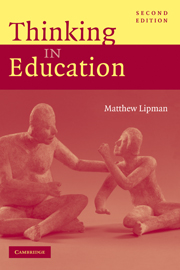Book contents
- Frontmatter
- Contents
- Preface
- Introduction to the Second Edition
- PART ONE EDUCATION FOR THINKING
- PART TWO COMMUNITIES OF INQUIRY
- PART THREE ORCHESTRATING THE COMPONENTS
- PART FOUR EDUCATION FOR THE IMPROVEMENT OF THINKING
- 9 The Transactive Dimensions of Thinking
- 10 Education for Critical Thinking
- 11 Education for Creative Thinking
- 12 Education for Caring Thinking
- 13 Strengthening the Power of Judgment
- Bibliography
- Index
12 - Education for Caring Thinking
Published online by Cambridge University Press: 05 June 2012
- Frontmatter
- Contents
- Preface
- Introduction to the Second Edition
- PART ONE EDUCATION FOR THINKING
- PART TWO COMMUNITIES OF INQUIRY
- PART THREE ORCHESTRATING THE COMPONENTS
- PART FOUR EDUCATION FOR THE IMPROVEMENT OF THINKING
- 9 The Transactive Dimensions of Thinking
- 10 Education for Critical Thinking
- 11 Education for Creative Thinking
- 12 Education for Caring Thinking
- 13 Strengthening the Power of Judgment
- Bibliography
- Index
Summary
THE PLACE OF THE PASSIONS IN THINKING
Any collection of the world's great sonnets would contain, critics apparently agree, mostly those of Shakespeare. And if anyone were to look for the best illustrations of multidimensional thinking, one would turn again to the “Metaphysical Poets,” especially Shakespeare and Donne, whose works express a balance of critical, creative, and caring thinking. Shakespeare, for example, does not hesitate to begin a sonnet with a critical question as to how he should begin – with what sort of simile: “Shall I compare thee to a summer's day?” His figures of speech are highly inventive: Every sonnet contains highly imaginative metaphors. And at the same time, his feeling for the person to whom the sonnet is addressed is usually an intense love and admiration that guides his choice of words and images. Likewise, Heloise's love letters to Abelard rise to the level of great literature because they interfuse critical and creative thinking with the tender passion that permeates her writing.
It is this matter of passion that is most controversial in the proposal to explain thinking as a combination of critical, creative, and caring thinking. We tend to identify critical thinking with reasoning and argumentation, with deduction and induction, with form, structure, and composition. We fail to see how profoundly our emotions shape and direct our thoughts, provide them with a framework, with a sense of proportion, with a perspective, or better still, with a number of different perspectives.
Information
- Type
- Chapter
- Information
- Thinking in Education , pp. 261 - 271Publisher: Cambridge University PressPrint publication year: 2003
